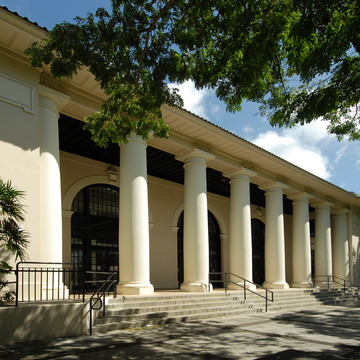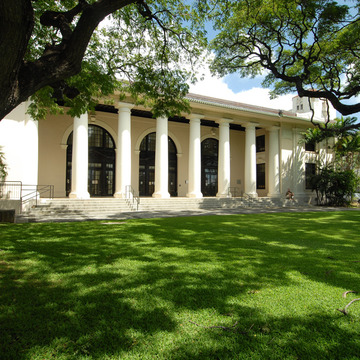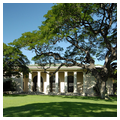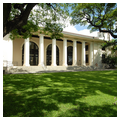This Carnegie library has gone through three distinct building phases, which are readily perceived along the building's sides on the coffers of the overhanging eaves. The original front section, with its twenty-foot-high Tuscan-columned entrance lanai, retains its prominent bronze doorways and bronze double-hung windows, as well as the two-story skylit lobby and the cast-iron stacks, whose structure supports a mezzanine level. In 1929, Dickey transformed this classical box into a Hawaiian place by including a lushly planted courtyard with first- and second-story lanai defining three sides. The 1992 extension and remodeling sensitively maintained the spirit of the earlier structure, although the courtyard plantings were reduced to accommodate Hiroki Morinoue's floor art, Ocean Currents. The Edna Allyn Room, housing the children's section, retains its wall murals (1934–1935) by Juliette May Fraser, which depict Hawaiian legends.
The Honolulu Library and Reading Room Association is considered the forerunner of today's statewide public library system. Started in 1879 at the instigation of William G. Johnson, this organization, for annual individual membership dues of six dollars, provided “a reading room for mechanics where they could spend an evening enjoyably away from the allurements of the saloon.” Supported by King Kalakaua, Queen Emma, and Bernice Pauahi Bishop, among others, the association's 19,000 books became the core of the Library of Hawaii's initial 30,000-volume collection. In addition, the Hawaii Historical Society contributed another 1,325 books to meet a condition of Carnegie's $100,000 bequest. New York City architect Henry D. Whitfield was the brother of Andrew Carnegie's wife, Louise. He also designed the Federal Building and Post Office in Hilo (HA36) and other Carnegie libraries, including two in Cleveland and one in Minneapolis.







